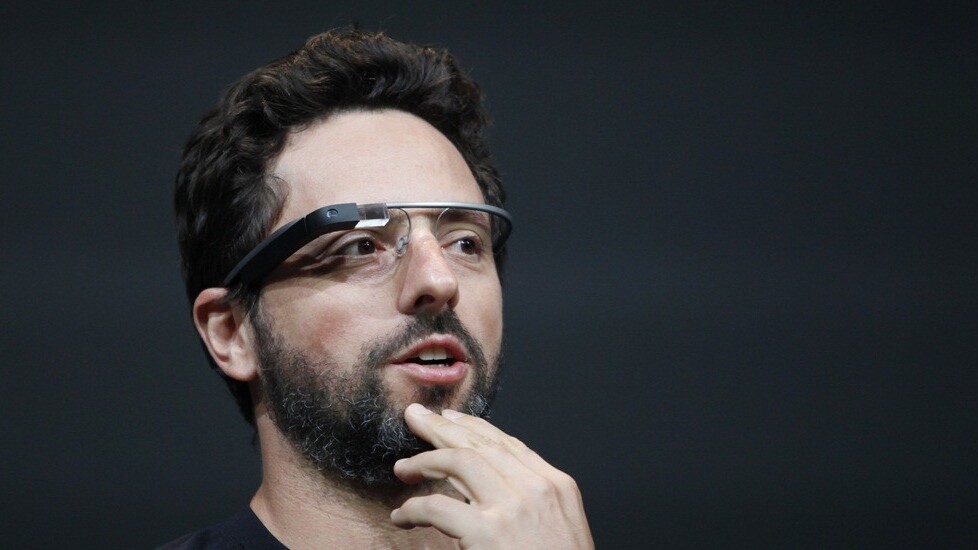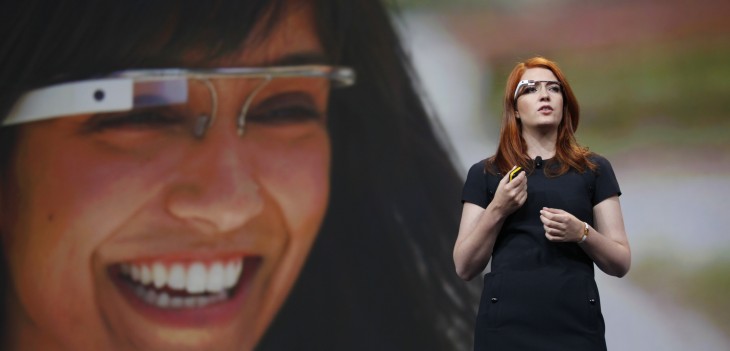
Today Google sat with a number of its Glass employees to answer a few formal questions, and a number from the audience that packed Room 7 of the Moscone Center in San Francisco. The session was a brief 40 minutes, as have been other moots at the I/O event, excepting that mammoth 215 minute keynote that kicked the event off.
The following text is a rebuilt rendition of the questions asked, and the answers tendered during the session. Do note that responses from Google staff are paraphrased from their answers, while the final section is a summary of the responses given to audience questions.
Google’s Questions
Directed at Isabelle Olsson, lead industrial designer of Glass: You have been on glass “since the prototype was still a phone attached to a scuba mask,” how did we get form there to here? And what is next?
It was very clear from the start that this was not incremental improve on what already existed. Instead, Glass is something new. It’s a new kind of wearable technology.
Building something like Glass is very messy at points. I never forget my first day on the team. I walked into a room full of people with crazy things on their head. How do you go from something like that to what we have today? We have taken a reductionist principle, removing everything that isn’t required.
We focus on three key areas:
- Lightness
- Simplicity
- Scalability
By lightness what we mean is pretty straight forward: we are obsessed with weight. Not like the fashion industry, but we do care about every single gram. If Glass isn’t light, we won’t want to wear it for more than 10 minutes. This implicates balance as well, meaning how heavy is Glass on your nose?
But lightness is also visual, which is part of the reason that we hid components behind the frame of the device itself. Regarding simplicity, we initially thought that it would require dozens of adjustment points. The current version sports just one.
Glass is built to be scalable. In this stage what that means is that you can remove the frame from the main board. The two are separable by a screw. Other companies can therefore create hardware for the guts of Glass to help prop it up on your face.
So, Glass is a hardware project as well as a software project.

Directed at Charles Mendis, an engineer working on Glass: The idea that Glass is both a device and a platform, could you expand on that?
We want Glass to have a big footprint. A core principle of Glass is that we build on the same APIs that you do. All Google products that run on Glass are built on top of the same APIs that are open to others. So, Google Now is built on the same API as the Facebook application.
A similar concept will be in effect for the Glass Development Kit, or GDK. However, we are looking for feedback in terms of what to build. We need to know what people are doing with Glass, what the Explorers are up to. We will build an API that suits what is needed. The GDK, however, is not right around the corner in terms of release. Instead, Google wants to incorporate feedback from the community.
Directed at Steve Lee, Glass product director: The Explorer has been an almost unprecedented way to introduce products. Why did Google pick that path?
Why are we here? Because we believe that Glass can transform the way that people use technology. The Explorer program is an important part of how Glass is being taken to the world. Who are the first people to get Glass? Developers!
To fully realize the potential of Glass we needed developers to work on on the platform. I’m happy to say that by earlier this week we had invited all 2,000 Explorers to pick up their device. The next group will be those who signed up using the hashtag #IfIHadGlass.
We picked 8,000 people from more than 100,000 applications. Invites will be rolling out soon to this non-developer group. It’s comprised of educators, dentists, and the like. We’re excited to see what they will do with Glass.
We’re going to update Glass every month. This will include both new features and bug fixes.
Directed at each in turn: If you could ask the developers to build on thing on glass what would it be?
Steve: I am an exercise fanatic, and would love to have a fitness app on Glass, and to have it integrate with my heart rate monitor. With that app, I could have information relevant to my workout fed to me, without breaking my stride. This would also make cycling a much safer activity.
Charles: I would love to be able to pay with Glass. To just say, ok, pay, and then move on.
Isabella: I’m really in to karaoke. If there was a way to sing and have the lyrics located in Glass, so that you could face your drunk friends as you scream, that would be awesome.
Audience Questions
Question: I’m curious what you think about the privacy questions that Glass raises, and if it is different from a smartphone in terms of etiquette, and how much data will be tapped [stored] by Google?
The social implications and etiquette have been at the top of Google’s mind since the beginning. And not just for people who buy Glass, but for the people around them as well. Google is proud of how seriously the team is taking it.
There are examples of how the technology has been designed with social implications in mind: The display is above the eye, for example. Google learned early on the importance of eye contact among humans. I know if you are paying attention to me, as we have eye contact. And I know if you are looking up and not paying attention to me, but instead to Glass.
Many privacy questions relate specifically to the camera. Google, knowing that it mattered, decided that you had to either push a button, or speak to it, to activate it. This provides a social cue as to what you are doing, akin to holding up a smartphone when you want to take a picture.
A third example: When Glass is active, its display is lit. Observers can see that. The display will be active when Glass is active, period. That will be part of the GDK, and is part of Google policy. Apps will not be allowed to fail this requirement.
Finally, you have to stare at someone to record them. If you stare at someone in the bathroom, they are going to notice.
Follow up question: Facial recognition?
Facial recognition is something that Google has worked on. They can imagine it existing through a third party. The company appeared to decline stating that they would build it themselves, likely to avoid painfully ignorant headlines.
The company is “not scared” of it, but wants to ensure that it has clear user benefit.
Question: Is the side of Glass multitouch?
It is! And Google claims that it intends to improve it. Right now, for example, a two-finger swipe down motion causes a different action than a one-finger swipe down action.
Question: Are you planning on making Glass less noticeable?
Google built five different colors of Glass in order to satisfy different personalities. After wearing them around for almost a year, Google “started seeing how important colors are. In the company’s view, they are “more important than you would ever imagine.” The company intends to release new colors in the future.
Question: How does the display work? Is it a small projector? An LCD display? And, do you see people using it for short-term interaction, or for longer-term interactions?
Google had no comment on the details of how its technology worked. It did note, however, that the screen is ‘projected’ out around six or seven feet, or that is at least how it feels.
Regarding the duration of interaction with Glass, the company does not intend it to be used to be used watch a full length movie or book. That, Google said, would be uncomfortable. The company instead imagines that interactions with Glass will be on the “micro” level.
Question: How did you pick the first five colors for Glass, and how did you test them?
Google built monthly prototypes of Glass, which gave them the benefit of being able to product a number of color options. They then watched to see which colors were fought over. This, Google said, was a good way to see what was “resonating” with people.
The company wanted “poppy” colors for folks that wanted to be spoken to, and “bland” colors for those who did not
Question: How do you reach the mainstream with the promise of Glass?
Google claims to be surprised at the reaction to Glass, not only on Silicon Valley, but also among normal people. Regular folks, like the rest of us, are still trying to figure out what Glass is, and what it might become.
The company, however, does in fact think that Glass will become part of the mainstream. That was a surprisingly bold statement.
Question: What does Google need in terms of better components for Glass?
Given that Glass shares much with the smartphone industry, its needs are similar: it needs better, higher-capacity batteries. That technology, unlike processors is not “doubling ever year.”
Question: Bluetooth headsets enjoyed a time in the sun, but later became reviled as a negative cultural marker. Does Glass risk the same fate?
This is something that Google has specifically thought about. People, Google stated, never say that they enjoy being around folks wearing a Bluetooth headset. By contrast, they want people who spend time with people who have Glass to have their lives enriched.
Read other stories from Google I/O 2013 here.
Top Image Credit: AFP/Getty Images, second image AFP/Getty Images
Get the TNW newsletter
Get the most important tech news in your inbox each week.




